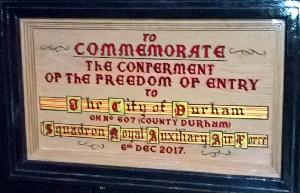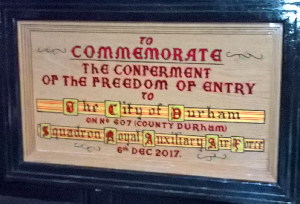
Photo: Dorothy Hall

Photo: Dorothy Hall
To
Commemorate
the Conferment
of the Freedom of Entry
to
The City of Durham
on 607 (County Durham)
Squadron Royal Auxiliary Air Force
6 Dec. 2017
Briefing Note for the Charter Trustees of the City of Durham On No 607 (County of Durham) Squadron RAuxAF
Background
Lord Trenchard created the Auxiliary Air Force (AAF) in 1924 as a part time volunteer force to support the RAF in both peace and war. Altogether some 21 auxiliary squadrons went to war in 1939 and they played a most significant role throughout the war.
In the early 20th century the army was largely recruited from local populations into county based units such as the Durham Light Infantry. The AAF was formed on a similar principal with units being named for counties and cities and located either within or close to its named area and drawing its recruits from the area.
No 607 Squadron AAF was formed 17th March 1930 and it needed a home base in Durham. In October 1916, the airfield that subsequently became Sunderland Airport started as a Flight Station for 'B' Flight of No. 36 Squadron of the Royal Flying Corps (RFC), and was originally called Hylton. Royal Flying Corps was given the task of Home Defence, setting up a number of squadrons, with flights spread over the length of the British coastline. No 36 Squadron was tasked with the defence of the NE coast. On 27 November 1916, a patrol of B.E.2cs intercepted two groups of Zeppelin airships over the North East coast. Lieutenant IV Pyrott destroyed LZ34 that crashed into the mouth of the Tees; the sight of this caused the other airships to turn back. The only other action that the squadron was involved in was the unsuccessful attack on Zeppelin L42 over Hartlepool on New Years Day 1918.
After the end of the First World War, the area around Usworth was returned to non-flying use. It languished unused for over a decade, until being re-activated as RAF Usworth on 17 March 1930 as the home of No 607 (County of Durham) Squadron.
The Early Years
In September 1932, the airfield was ready to receive personnel under the command of Leslie Runciman, later Viscount Runciman. The personnel of No 607 County of Durham Squadron came from all walks of life locally and were trained by a nucleus of regular RAF personnel, including 2 Qualified Flying Instructors. Evenings and weekends were busy when the part time airmen turned out for training. Training continued in earnest, and in June 1934 the squadron proudly flew nine of its Wapiti aircraft in formation past its first Honorary Air Commodore, the Marquis of Londonderry. The squadron continued training as a light bomber squadron until September 1937 when it was re-designated as a fighter squadron.
Eventually equipped with Gloucester Gladiators it was called to action on 10th November 1939 moving to Merville by 15th November as part of the Air Component of the British Expeditionary Force.
On 12th April 1940 the squadron moved to Abbeville and re-equipped with Hurricanes. The squadron saw fierce and continuous action leading up to the evacuation at Dunkirk and also provided cover during the evacuation itself. During its time in France the squadron was responsible for destroying over 70 German aircraft.
On return to the UK the squadron was sent back to Usworth to re-build arriving back on 5th June 1940.
The Squadron Defends Durham
On the 15th August the Luftwaffe was still concentrating its efforts directly against the RAF and on that day they launched a major assault. In the mistaken belief that the North was largely undefended the assault included a flanking attack against the North of England. This comprised two large formations the most Northerly of which was targeted against Acklington and Usworth. The response to the attack was masterful with 72 Squadron engaging the enemy off the Farne Islands and then as part of the raid flew over Durham 607 squadron, fighting over its home county, engaged the enemy to great effect causing the enemy to abandon its attack. The squadron shot down two aircraft and damaged several more. The defeat was complete and the Germans never tried a major flanking attack in the North again. The squadron had fully justified its County title.
Battle in the South
On 9th September the squadron moved to Tangmere with 16 Hurricanes and twenty-two pilots. Tangmere came under No 11 Group where the majority of fierce air fighting took place and where the outcome of the battle was decided. The County of Durham Squadron was quickly engaged in mortal combat. Most notably the squadron took part in the battles of the not to be forgotten day of 15th September; on that day they were scrambled to action four times with the poor ground crew given hardly enough time to re-arm and re-fuel the aircraft.
The County of Durham fought heroically and with great distinction until the battle was essentially won and it was sent back to Turnhouse on 10th October 1940 for rest and recuperation and it was used in a training capacity to bring new pilots to operational readiness.
The squadron was selected to become the first fighter-bomber squadron and after training at Martlesham Heath it was posted to Manston where it took the fight to the enemy in France.
Posted to India
After numerous moves around the country and the award of two more battle honours the squadron was posted to India arriving in Bombay on 20th May 1942. The squadron had built a very strong reputation and it was to build on this by winning battle honours for Arakan 1942 - 1944, Manipur 1944 and Burma 1945. The County of Durham Squadron was disbanded on 19th August 1945 in SE Asia. Although none of the original Auxiliary pilots remained and the squadron was a very different one to that which joined battle with the Luftwaffe in France many of the ground crew recruited from Durham were still serving with the squadron and most importantly the spirit of the squadron was unchanged. Throughout a most eventful five years the squadron proudly bore the name of the County of Durham.
The Squadron is Reformed
On 10 May 1946, the County of Durham Squadron reformed over the border at RAF Ouston in Northumberland as a day fighter squadron of the Royal Auxiliary Air Force. Four original members of the squadron returned with Squadron Leader Joe Kyall in command, Flight Lieutenant Francis Blackadder, Flight Lieutenant JM Brazin and Flying Officer REW Pumphrey who had been a prisoner of war for five years. Initially the squadron was equipped with Spitfire Mk XIV but they were exchanged for Spitfire XXII in 1948. In 1951 the squadron converted to the de Havilland Vampire FB V day fighter which it flew until it was disbanded.
The squadron had returned home and was once again drawing its manpower from Durham and the North East. The Royal Auxiliary Air Force was stood down and all squadron disbanded on 10th March 1957.
The Awarding and Laying up of the Squadron Standard
Although the squadron had ceased to exist on 10th March 1957 the Squadron standard had been produced. On a Sunday afternoon on the 22nd May 1960 on Palace Green, in the Shadow of the Cathedral and in the company of Hawker Hurricane Mk 1 P-2617 that had been flown by the squadron during both the Battle of France and the Battle of Britain, a moving ceremony took place.
In the presence of 120 ex-members led by the last Honorary Air Commodore Viscount Runciman, Marshal of the RAF Sir Dermot Boyle, a former Chief of the Air Staff, handed over the Standard on behalf of the Queen after which it was dedicated by the Dean of Durham.
A special service in the Cathedral followed during which Viscount Runciman gave the Standard into the keeping of the Dean. Tangible links with the squadron can be found in the Cathedral where the squadron dead, many of whom came from Durham and the North East, are honoured on an oval stone tablet in the south transept. The squadron standard is situated above the memorial in the south transept.
Reborn Again
The County of Durham Squadron was re-formed on 5th January 2015 as part of the new reserve forces initiative; the Squadron is now a General Service Support Squadron (GSS). The squadron has re-forged its links with Durham since its reformation taking part in Armed Forces Days, Mayor making ceremonies, a concert in the Cathedral, Battle of Britain and Remembrance events in Durham over the last two years. Lady Peel is the current Honorary Air Commodore of the Squadron. The story of the County’s squadron is a remarkable one with many local young men giving their lives for the country whilst others who survived returning to continue the traditions of the squadron after the war. It is particularly moving that the County of Durham squadron was able to defend its own County during the major air assault of August 1940. The squadron was involved in some of the most intense air fighting and throughout the war it carried with pride the name of County of Durham squadron.
We would be most grateful if the Charter Trustees would consider bestowing the very great honour of the Freedom of the City of Durham on No 607 (County of Durham) Squadron on Palace Green on the 23rd June 2018 where the final act of disbandment and the laying up of the standard was carried out in 1960.
Tim Willbond, Group Captain RAF (Retd), Vice Chairman (Air) The Reserve Forces and Cadets Association for the North of England.

